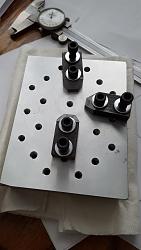Milling small parts on my RF-30 clone, can often be a pain. But after viewing a YouTube video by Tom Lipton (OxTools), I decided to build a clamping block that can be held firmly in the 6" mill vice. The block of aluminum measures approximately 4" x 5" x 1 1/4", and was fly cut; then drilled and tapped for 1/4-20 allen type socket head screws. I also made a set of hold downs from some 3/8" x 3/4" hot rolled mild steel. Placement of the threaded holes was somewhat arbitrary, but are spaced no more than 1" apart, with a few at 1/2" spacing. The nice thing about it is, the base block is thick enough that any milling or drilling marks can easily be done away with, using the fly cutter; making it as good as new whenever needed.
-EN



 LinkBack URL
LinkBack URL About LinkBacks
About LinkBacks



 Reply With Quote
Reply With Quote





Bookmarks